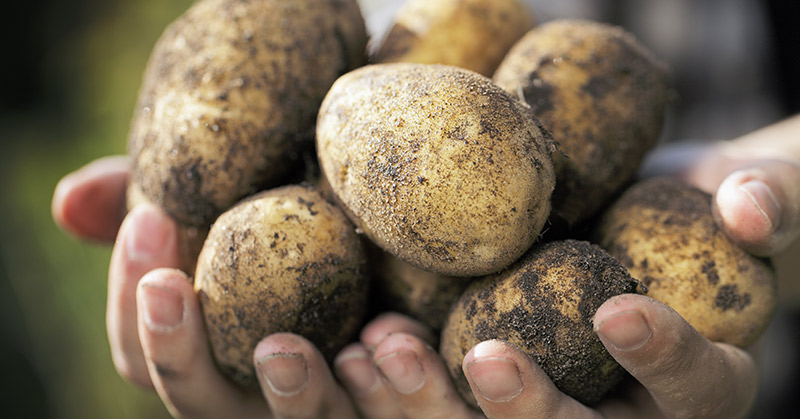French fries, chips, baked potatoes, mashed potatoes – the humble potato can do so much in our kitchen. This versatile vegetable isn’t just super easy to cook with, but it takes very little effort to grow them. A single potato patch in your garden can take a handful of potatoes and turn them into a mighty bounty of dozens of potatoes. Here’s how to grow potatoes.
Where to plant your potatoes
Potatoes require full sun in order to grow and produce their delicious, starchy tubers. Before planting, your soil should be thoroughly tilled, as potatoes prefer to grow in light, aerated, well-draining soil. Potatoes prefer a slightly more acidic soil with a pH of 5.0 to 7.0. But potatoes are durable and adaptive. You can get a pretty decent crop even if the soil isn’t ideal.
Potatoes like lots of water. Keep them well watered, especially while flowering.
When to plant potatoes
Potatoes are an early spring vegetable. As soon as your soil can be worked, your spuds can go in the ground. It is worth noting though that, while potatoes are hardy and able to grow in cooler weather, your potatoes won’t really get started growing until the soil is above 45 degrees Fahrenheit. If it appears your area will experience a hard frost, cover your potatoes to offer them protection from the cold.
Typically a potato crop planted early enough can be harvested by the beginning of June. A second crop of potatoes can go in the ground as late as mid June and be ready for harvest in the late fall, near your first hard frost. Be sure to till and fertilize the soil you’re growing potatoes in, or select a new potato patch.
Read More: When And How To Harvest Potatoes
Preparing your potatoes for planting
Growing potatoes is a little bit more involved than tossing some old spuds in the dirt. Starting about two weeks before your planting date, place your seed potatoes in a well lit room with temperatures between 60 and 70 degrees Fahrenheit. In these conditions, the potatoes will begin to sprout. Once they’ve sprouted, use a clean knife to partition the potato sprouts. Each piece of potato should have 1-2 sprouts. If you have a small potato that’s sprouted, plant it without cutting it.
How long does it take to grow potatoes
Potatoes are ready to harvest 70-100 days after sowing, depending on the variety you’ve chosen. Small potatoes can be harvested at 10 weeks, while you’ll want to wait a bit longer for larger potatoes.
Because potatoes are cool weather tolerant, you can easily grow two crops in a single year. If you plant your potatoes early, as soon as your last hard frost has passed, you can likely harvest by mid June and then plant another crop of potatoes for harvest in late fall, before your first hard frost.
When to harvest potatoes
Late in their growing cycle, the foliage of the potato plant, which should be fairly large, will begin to turn yellow and die back. This will happen approximately two to three weeks after the flowering cycle of the plant has ended. Once the foliage has died, wait two weeks before harvesting. Once harvested, store your potatoes in a cool, dry, dark place. Some types of potatoes keep better than others, so it’s best to use your crop when it’s fresh.
How to grow potatoes in a container
Growing potatoes in a container is similar to in the ground, though there are some advantages. One way to grow in a container is to fill it with only a few inches of soil, plant your potatoes, and wait for them to grow. When they’ve sprouted, add another couple inches of soil and another layer of potatoes. Do this until the container is full. When harvest time comes, your entire container should be brimming with potatoes!
Summary
- Potatoes require full sun
- Plant potatoes in tilled, airy, acidic soil
- Water thoroughly
- Sprout your potatoes before planting
- Plant after risk of hard frost
- Harvest two weeks after foliage has died
- Store your crop in a cool, dry, dark place.













